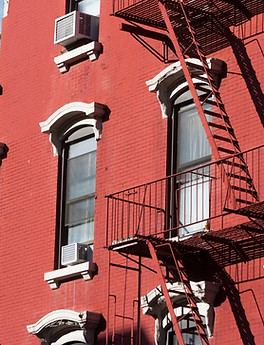
Adaptive Reuse
Adaptive Reuse (AR) refers to the practice of converting older residential and commercial buildings to new uses including apartments, lofts, office space, retail space and even small hotels. Effective AR policies use tax incentives and low-cost loans to encourage developers to purchase and re-develop buildings or whole neighborhoods rather than continuing to expand the built environment into open space and natural areas.
Many AR projects in the past were focused primarily on blighted urban neighborhoods because of a need for low income housing and jobs. Today AR has become the new "green frontier" - a place where the utilization of existing structures, the reclamation of materials, reduction of the waste stream, and the preservation of open space are the prime considerations.


The New York City Governors Island Redevelopment Initiative is a large scale example of adaptive reuse consisting of development sites and more than 50 historic buildings ready to be repurposed for various uses.
In Playa Vista, CA, MATT Construction created a new 450,000+ sf tech campus headquarters for Google in the historic wooden hangar originally erected by Howard Hughes to build the Spruce Goose airplane.
Springfield, MO has been working for over 15 years to reclaim historic buildings as well as cleaning up and facilitating the redevelopment or reuse of brownfields sites and potentially contaminated properties.
Resources
The City of Los Angeles has developed a comprehensive white paper on post-Covid solutions to adaptive reuse.
Long Beach, CA, has produced a colorful and informative Adaptive Reuse Technical Manual.
The National Trust for Historic Preservation provides information on how to support adaptive reuse of historic buildings.
The Design Trust for Public Space in New York spearheaded many adaptive reuse projects that can serve as models for other municipalities working on similar ventures.
References
[1] Rabun, J. S., & Kelso, R. M. (2009). Building evaluation for adaptive reuse and preservation. Hoboken, NJ: Wiley, 27-95
[2] Bullen, P. A., & Love, P. E. (2009). Residential regeneration and adaptive reuse: Learning from the experiences of Los Angeles. Structural Survey, 27(5), 351-360.
[3] Kotval-K, Z., et al. (2017) Should the public sector play a greater role funding brownfield redevelopment projects? A transatlantic comparison. International Planning Studies, 22(4), 366-383.
[4] Chamberlain, F. F., & Riggs, W. (2018). The TOD and Smart Growth Implications of the Los Angeles Adaptive Reuse Ordinance. Sustainable Cities and Society, 38, 594-606.
[5] Ryberg, S. R. (2011). Preservation at the Grassroots: Pittsburgh’s Manchester and Cincinnati’s Mt. Auburn Neighborhoods. Journal of Planning History, 10(2), 139-163.
[6] Boschmann, E. E., & Gabriel, J. N. (2013). Urban sustainability and the LEED rating system: Case studies on the role of regional characteristics and adaptive reuse in green building in Denver and Boulder, Colorado. The Geographical Journal, 179(3), 221-233.
[7] Iacovidou, E., & Purnell, P. (2016). Mining the physical infrastructure: Opportunities, barriers and interventions in promoting structural components reuse. Science of the Total Environment, 557-558, 791-807.
[8] Mısırlısoy, D., & Günçe, K. (2016). Adaptive reuse strategies for heritage buildings: A holistic approach. Sustainable Cities and Society, 26, 91-98.


